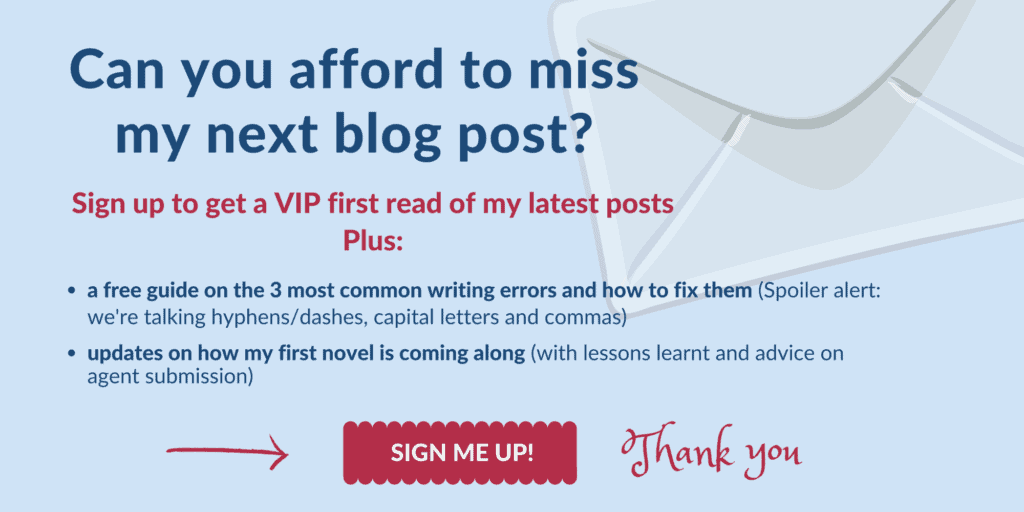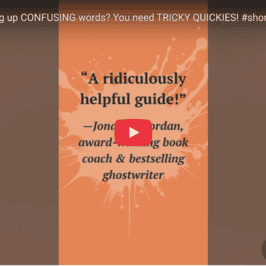
Looking to reduce your word count? Discover how I cut 15,000 words from my manuscript, and made it better in the process.
Since getting feedback from beta readers and an authenticity reader, I’ve been working on final improvements to my manuscript, one of which is to chop, chop, chop the word count.
It was a hefty 130,000 words when I started, which is considered far too long for a mystery novel, especially if you’re seeking to traditionally publish. I’m now at 115,000 words, a far more respectable length (although I may still need to do a bit more chopping).
Why shorten your manuscript?
Before we dive into the ‘how’, let’s take a quick look at the ‘why’.
Don’t misunderstand me. I’m not saying for one minute that there isn’t a place for lengthy novels. You’ve only to look at TCK Publishing’s article about 10 of the longest books written in English to see that length isn’t necessarily an obstacle to publication.
However, if you’re a first-time novelist in the 21st century, it makes sense to remove one more obstacle between you and that elusive book deal.
If you're a first-time novelist in the 21st century, it makes sense to remove one more obstacle between you and that elusive book deal. – How to cut thousands of words from your book manuscript (and improve it) Share on XA book should be as long as it needs to be. Needs. That’s the important word right there. If your book is full of fluff, filter words, lengthy descriptions and the passive voice, the pace will suffer and readers will quickly become bored.
The publishing industry looks for different maximum book lengths depending on genre. Jordan Lyons has written about Kindlepreneur’s fantastically in-depth research on book word count in the top 15 Kindle categories. Different websites offer varying lengths by genre, but unless you’re writing fantasy (which can be longer – up to 150,000 words seems to be acceptable), aim for a word count between 70,000 and 100,000 words. Young adult fiction is often shorter than this, and there are slight variations across genres.
Here are some good reasons for ensuring your book is as short as it can be:
- Trimming your word count will make your story more engaging and the pace of the book will be snappier. Who doesn’t want to give their readers a page-turner?
- Agents are more likely to reject a book that goes much over the expected word count for its genre. Why put this extra obstacle in your way?
- Even if your book makes it to publication (or you self-publish), readers have expectations of book length. If yours doesn’t fit these, it may be overlooked.
- Longer books cost more to produce, whether traditionally or self-published. Think about the extra pages, print and production involved. Publishers need to recoup these costs, so they pass them on to the buyers by increasing the price of your book. This may put off potential readers.
So, you know your target word count but you’re waaaayyyyy over. How can you get the length of your book down to a more respectable length AND improve your writing? Let’s take a look.
Macro level – the bird’s-eye view
Always take a macro view first. You don’t want to edit line by line, only to later remove a whole chapter that you have painstakingly edited.
You can quickly chop hundreds, even thousands, of words by asking yourself the following questions:
Do all my subplots advance the main plot?
Subplots shed light on your protagonist’s actions and motivations, feed into your novel’s theme, and add interest and intrigue to the main plot. At least, that’s what they should do.
Hold a magnifying glass over your subplots. Do they all really need to be there? If you could take out a subplot without damaging the overall story, it can probably go.
Do all my scenes advance the plot?
Every scene in your book should march towards each plot point, raising the stakes and guiding the reader through the story until the ultimate showdown in the final climax.
Do you have some scenes in which characters are just chatting about what has already happened (stuff that the reader already knows), or talking about events that are nothing to do with the main plot?
I had a scene that I loved, in which my protagonist gets one over on her bullying boss. I kept trying to justify its existence, but in the end, I had to admit that if I cut it out, the story wasn’t harmed in any way. That saved me over 1,000 words. (I still love it though; I may release it as a piece of flash fiction as I can’t completely let it go!)
Does my book start in the right place?
This is a great question to ask and may lead to an a-ha moment. Most new writers (and established ones, come to that) start their book too early. They begin with a load of backstory, or show their protagonist in their everyday world before the proper story begins. Ideally, your book needs to start in the heart of the action – in medias res. KM Weiland explains clearly how to do this.
Go through your first five scenes and imagine your book starting at each one instead of your current opening scene. Does it make a more gripping beginning? More engaging? Emotional? Entertaining?
Go through your first 5 scenes and imagine your book starting at each one instead of your current opening. Is it a more gripping beginning? More engaging? Emotional? Entertaining? – How to cut thousands of words from your book manuscript… Share on XIf the answer to any of those is a big fat YES, you probably need to either move things around or cut everything up to that point and weave some of it back in through later scenes.
Two of my beta readers suggested that the first few scenes in my book needn’t be there. They kindly refrained from using the word ‘boring’! Oddly enough, an earlier draft of my novel started after those first scenes, and I added them later to give more backstory to my main character.
I saved around 4,000 words by cutting out those scenes and saving just the essential bits of info that the reader would need to get to know my main character. I then threaded these nuggets into later conversations and passages.
Are all my characters essential?
If you’ve decided to cut any subplots, you may have already found some superfluous characters. You may also have some characters that pop up in the main plot but do nothing to advance it.
Less (or rather, fewer!) is always better than more when it comes to characters. Your readers, and you, need to keep up with the names, personalities and motivations of all your characters, so don’t create more work than you need to.

Micro level – the frog’s-eye view
Now you’ve trimmed those bulky, superfluous (I know I’ve already used that word in this post, but it’s one of my all-time faves!) subplots, scenes and characters, it’s time to delve into your manuscript line by line.
Be warned: this takes time and can be boring and painful in equal measure (shameless plug of my editing services). Thoroughly edit your manuscript, paying attention to the following elements:
Words to watch out for
- Adverbs – Pay particular attention to ones that end in ‘—ly’. These can be a sign that you’re ‘showing’ rather than ‘telling’.
Example: “He quietly whispered to her” becomes “He whispered to her” - Adjectives – You may have used two synonymous adjectives to described the same thing.
Example: “A terrifying, scary wolf was chasing her” becomes “A terrifying wolf was chasing her” - Passive voice – Look out for constructions containing ‘was’, ‘were’ and ‘that’. These are less engaging than the active voice, and often use more words.
Example: “The meal was enjoyed by everyone” becomes “Everyone enjoyed the meal” - Filler words – These are common words that can be removed without changing the meaning of a sentence. Examples are ‘that’, ‘very’, ‘quite’ and ‘began’. Bryan Collins provides a useful list of 30 filler words and phrases to look out for.
Example: “She was very worried that her mother would hear them” becomes “She was worried her mother would hear them” - Dialogue filler words – These fall under the umbrella of filler words but are such a common issue that they deserve their own bullet point. Unless absolutely essential (and it rarely is), avoid saying ‘Yes’, ‘No’, ‘I know’, and too many ‘Thank yous’ and ‘You’re welcomes’. Of course, this is how people talk in real life, but it slows the pace of the dialogue and becomes boring for the reader, without them even realising why. Other culprits are ‘Ah’, ‘Er’, ‘Uh’ and ‘Well’. ‘Hm,’ ‘mmm’ and mm-hmm,’ are others, but if you need to include these for characterisation purposes, take a look at my blog post about how to spell them!
Example: “Yes, I met him the other day” becomes “I met him the other day” - Filter words – These are a telltale sign you’re showing rather than telling. They are usually related to the five senses, plus thinking. They put a filter, or barrier, between a character’s experience and your reader. Examples are ‘felt’, ‘saw’, ‘thought’ and ‘tasted’. Instead of telling the reader what your character is feeling, seeing or touching, show it.
Example: “He heard a bird singing and thought it sounded beautiful” becomes “A bird was singing. It was beautiful.” - Redundancies – ‘She nodded her head.’ ‘He blinked his eyes.’ ‘They looked up at the sky.’ These are all examples of redundant words. You can’t nod with anything apart from your head. Only your eyes blink, no other part of your body. Everyone knows the sky is up, not down. Replace these with: ‘She nodded.’ ‘He blinked.’ ‘They looked at the sky.’
- Your personal tic words – Every writer, and I mean every, has their own tic words, including me. I love a ‘nod’ or a ‘shrug’. There isn’t a single manuscript I’ve edited (and I’ve edited a lot!) in which the writer hasn’t shown a preference for a certain phrase or word. If you use Scrivener, you can easily see the word frequency of every word in your book. Yes. Every. Single. Word. Go to Project > Statistics > Word frequency. Tell me your personal tic words in the comments!
Other elements to watch out for
- Lack of contractions in dialogue – When native English speakers talk, they tend to use contractions, rather than the full words (don’t, won’t, can’t, wouldn’t etc). Writing your character’s words without contractions, unless intentional (for example, due to historical accuracy or a character whose English isn’t fluent), makes for stilted, unnatural-sounding dialogue. We don’t all live in a Jane Austen novel!
Example: “We are going to miss the plane!” becomes “We’re going to miss the plane!” or even “We’re gonna miss the plane!” (don’t overuse ‘gonna’, but it’s useful to show colloquial speech, or a character’s particular way of speaking). - Too much stage direction – Look out for scenes in which you’ve over-described what characters are doing. The reader is more than capable of filling in the gaps.
Example: “He marched to the door, put his hand on the handle, flung it open, walked out and slammed the door behind him” becomes “He marched to the door, flung it open and slammed it behind him” - Unnecessary backstory – As far as possible, weave backstory into dialogue and action, rather than writing long paragraphs to cover it. The reader doesn’t have to discover everything about the protagonist’s past. Reveal it on a need-to-know basis.
- Too much description – This is similar to the backstory point above. Restrict description of setting, and characters’ thoughts and feelings, to what is pertinent to the plot.
- Repeating info the reader already knows – Just because one of your characters wasn’t around in the previous scene, it doesn’t mean that your reader has to wade through another character getting them up to speed in the next chapter. Consider simply saying, for example, that Carlos updated Tamara on the situation, or while he was updating her, so-and-so was doing such-and-such. The latter solution is a way of progressing the plot while letting the reader know that Tamara was receiving the info she needed.
Next steps
I know what you’re thinking. A lot of work, right? If you need to trim your word count, schedule some time each day or each week to work on it.
If this all sounds too much to get your head around, consider hiring an editor. They will not only help you to reduce your word count, but will also improve your manuscript in so many other ways, helping you to get it ready for the world and all those great reviews!
I offer line-editing and copyediting services. Drop me a line!
Disclosure: Some of the links on this page are affiliate links. This means, at zero cost to you, I will earn an affiliate commission if you click on the link and finalise a purchase. This helps me to keep this website running. I only recommend products and services that I trust and am comfortable endorsing. Find out more.









Leave a Reply